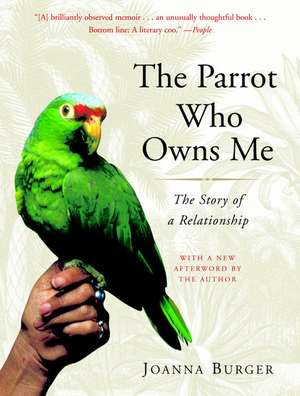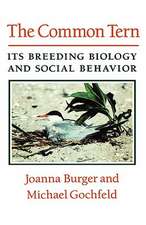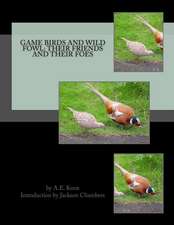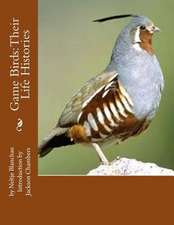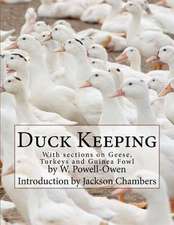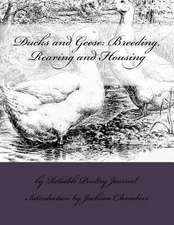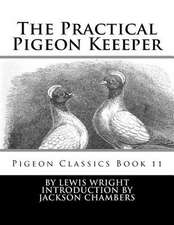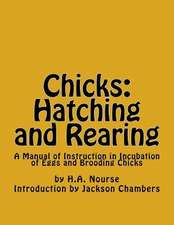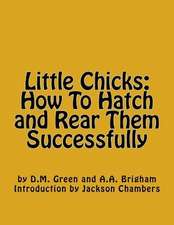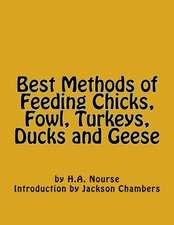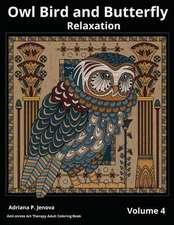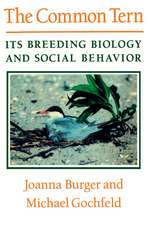The Parrot Who Owns Me: The Story of a Relationship
Autor Joanna Burgeren Limba Engleză Paperback – 30 apr 2002
The Parrot Who Owns Me is Joanna and Tiko’s story, as well as the story of the science of birds, and of parrots in particular. Woven into the narrative are insights and fascinating revelations from Dr. Burger’s work—not only about parrots, but also about what it means to be human.
Preț: 104.36 lei
Nou
Puncte Express: 157
Preț estimativ în valută:
19.97€ • 20.77$ • 16.49£
19.97€ • 20.77$ • 16.49£
Carte disponibilă
Livrare economică 24 martie-07 aprilie
Preluare comenzi: 021 569.72.76
Specificații
ISBN-13: 9780375760259
ISBN-10: 0375760253
Pagini: 272
Dimensiuni: 141 x 184 x 13 mm
Greutate: 0.18 kg
Ediția:Trade Pbk.
Editura: Random House Trade
ISBN-10: 0375760253
Pagini: 272
Dimensiuni: 141 x 184 x 13 mm
Greutate: 0.18 kg
Ediția:Trade Pbk.
Editura: Random House Trade
Notă biografică
Joanna Burger, a distinguished professor of Biology at Rutgers, has authored two academic books on bird behavior, and has written five books for lay readers, two of which she co-authored with her husband, Muchal Gochfeld, a professor of environmental and community medicine at Robert Wood Johnson Medical School. They live in Somerset, New Jersey.
Extras
Chapter 1: In Springtime His ThoughtsTurn to Love
My parrot, Tiko, didn't court me until five years into our relationship. I knew how attached he was to me, but it came as a complete surprise when one morning in early April his behavior toward me suddenly changed. I found his diminutive brightly feathered self on my bed, insistently poking his head under my hand to solicit preening. In the past, he'd had the good manners to perch on the banister outside the bedroom, patiently watching me sleep and waiting until I stirred before coming in for his ritual morning preening, which had typically lasted five to ten minutes.
That morning Tiko gently picked at my cuticle and fingernails with his tongue and beak for two hours while I drifted in and out of sleep, dreaming of jungles, jaguars, and brilliantly colored parrots flitting through the forest canopy. After breakfast, bleary from interrupted sleep, I started work. I'm a biologist, a professor at Rutgers University, and my specialty is ornithology. Tiko is a Red-lored Amazon, a distinguished member of a widespread Central American species. He has taught me a tremendous amount about bird behavior, but that's not why I have a perch for him in my home office. I enjoy his company, and usually he's a most considerate companion, valiantly standing guard over me, a silent sentinel, occasionally emitting a warning cry to protect me from the hawks he sees circling outside our picture window in Somerset, New Jersey.
But that spring morning, Tiko flew from his perch in my office, landed on my computer keyboard, and stomped over the keys, forcefully nudging my fingers away from their task. Even pinyon nuts, his favorite treat, did not deflect his desire; within moments he was back at my side. He began to make low mewing and moaning sounds that I hadn't heard before, while gazing pleadingly into my eyes. When I looked away, his mews and moans intensified until I reestablished eye contact. He gently nipped me with his beak-a kind of parrot kiss called "billing"-which I recognized from observing wild birds. He put his head flat against the desk, exposing his neck and hiding his beak.
I massaged the creamy skin on his nape, through feathers that are a pale sagebrush color tinged with electric blue. His skin is softer than a newborn baby's and very warm to the touch. Exposing his nape is a gesture of complete vulnerability: hawks and other predators target it for the kill.
After a few days of this, my husband, Mike, who has a Ph.D. in biology as well as being an M.D., and I suspected that Tiko was exhibiting classic male courting behavior. Our suspicions were confirmed when he began to scour the house for nest sites. He inspected the dark tight spots beneath our armchairs, couch, and television, behind books in the bookshelves, between the file cabinet and the daybed where I work in my office. Silent and intent, he spent only a minute or two in each place before flying back to stomp over my keyboard and nuzzle my hand.
I knew my parrot and I were close, but just how close, I was about to discover. Tiko finally chose the narrow slot under the credenza for what turned out to be "our" nest. The credenza is made of reddish cherry wood, about five feet long and waist high, with three low doors that open to cupboards, and drawers for silverware and napkins. Its bottom is a scant two inches off the floor. Tiko scrunched almost flat on his stomach to slither underneath it, and huddled there for long periods. God knows what he was thinking. When I ventured near, he gave a guttural cry.
"Hi, sweetie! What are you doing?" My voice held the lilting tone I would use with a five-year-old child. Even though Tiko was entering middle age-thirty-five years old in 1990, when this occurred-he responded well to being talked to and treated like a child. And, as we'll see, his behavior and intelligence were remarkably like a precocious three-year-old's.
That was, of course, before he became the hombre of the house, the passionate lover, the Don Juan of Somerset. His cries grew louder and he started growling, which sounded like the distant lowing of cattle. He peeked out from under the credenza, fixed me with his eyes, moaned enticingly, and ducked back into the darkness. He dashed to my toes, which he maniacally preened, hopped around my feet, then scooted back to the nest.
I knew from observing parrots both in the wild and in the lab that he was exhibiting what we ornithologists call "male nest-showing" behavior. I once watched this ritual in La Selva, a Costa Rican rain forest. Mike and I were on our way to the dry tropical forests of Palo Verde to study vigilance behavior in basking Black Iguanas, but we couldn't resist a quick detour to check up on Tiko's wild brethren.
We stayed at a research station run by the Organization for Tropical Studies (a consortium of universities), on whose board I served. Our spartan wood cabin was nestled into the edge of the jungle. We lit mosquito coils and settled into our bunk-bed cots, which were attached to the walls and so couldn't be pushed together. We lay under thin sheets, talking, as we always do, about the day, before drifting off to sleep.
We rose early to avoid the heat and made our way slowly along a winding path. The lowland tropical rain forest was thick with layers of vegetation. A rich leaf litter covered the jungle floor, the trees rising out of it tall and dense. We kept our eyes peeled for the deadly Fer-de-lance, one of the most feared and dangerous snakes in Central America and tropical Mexico. Unlike other vipers, which retreat when approached, the Fer-de-lance will strike if disturbed. Its dark mottled pattern blends perfectly with the jungle floor. We took our time, stopping now and then to focus our binoculars on the birds that fluttered through the canopy.
We walked for a couple of hours, often stopping to watch manakins, warblers (some of the same species that migrate north), brightly colored tanagers. When we were about three miles in, the dense forest opened and we found ourselves on the edge of a clearing where a storm had felled the larger trees. After the jungle gloom the clearing was light and airy; the early slanting sun created a patchwork brightness over the jumble of snags and green shoots. We smelled decaying undergrowth, wet leaves, and the sweet odor of rotting figs strewn near us on the ground. The figs were brownish-black, smaller and less fleshy than our cultivated varieties, a favorite parrot food. Some of my colleagues have tried them; they're less sweet than our cultivated varieties. But if you were starving, they'd do quite nicely. The perfume of rainy-season flowers was heavy in the air and hummingbirds hovered at the lovely Heliconia, or Bird of Paradise, with its twisting yellow blooms, and the bromeliads that wound through the canopy, their leaves festooning the treetops.
The drone of cicadas was suddenly broken by the screeches and calls of two dozen parrots flying overhead. Each mated pair in the flock flew only a few inches apart, moving at great speed in perfect tandem. The birds were compact green missiles: their blunt green tails extending behind them gave them the appearance of powerful arrowheads, perfectly suited for flight, unlike their stubby, toppling gait on the ground. Their journey was filled with a loud chatter that took me back to Tiko. A pang of longing for him mingled with delight for his wild brethren, flying free in search of fruit and fresh blossoms.
Mike and I slipped into the shadows at the edge of the clearing and sat on a fallen log, hidden by the broad leaves of a banana tree. A pair of parrots peeled off from the flock, swooped down, and landed on a snag at the edge of the clearing. We wondered fleetingly if a hole in the dead tree was an old nest site of theirs. Wild parrots are shy; if they had known we were there they would have melted into the wall of green, but they were unaware of our presence. Parrots have sharp sight and hearing but a poor sense of smell, so all we had to do was keep quiet and still to remain undetected. Mike and I grasped hands in excitement.
It was very still in the clearing. The female stood coyly silent and immobile. She watched the male sidestep with a slight bobbing motion of his head; his lead leg extended like a dancer's along the branch on which they were perched. With a backward glance at her, he hopped down to a small opening in the trunk of the tree. He turned his head from side to side, then pecked tentatively at the hole's edge, dislodging a small piece of bark, which he flung over his shoulder, giving him the opportunity to glance back at his mate, who was watching his every move. He walked slowly back toward her, his head held low, neck feathers slightly erect, just the way Tiko would approach me during our courtship seasons. By the time he reached her, his bill was tucked neatly under his chin and his eyes were half closed.
The pair was silent. Mike and I whispered together, marveling at how the male's behavior mirrored Tiko's when he approached me for preening. The pair must have been well established or the male would not have placed himself in such a vulnerable position. How similar to human beings! I glanced at Mike, remembering the heady but often tense first years of our marriage, as we built the bond of trust that these wild birds displayed.
With a sideways glance the female turned toward the male and began to tentatively preen his neck feathers. He lowered his cream-colored eyelids until we glimpsed only a sliver of his yellow irises through our field glasses. Soon, the female swiveled her head, lifted a wing slightly, and began to run her bill through her own back feathers, indicating to him that it was his turn to preen her.
He sidled up and delicately extended his bill, making his intentions clear without intruding. I was moved by his discretion, his lack of presumption. Although she had given him a clear cue that she wanted to be touched, his attitude indicated-dare I say it?-consideration for her wishes; something akin to respect.
The female parrot drooped her head until her bill brushed the branch. He slowly began to preen her feathers, taking each one delicately in his hooked bill, sweeping it clear of dust and dirt. He dabbed his bill into a special gland at the base of his tail, picking up a small amount of oil, with which he coated her feathers. The oil is very fine, light, and odorless, so subtle it is hardly noticeable. It helps feathers stay supple and strong, and keeps the barbs interlocked so they repel rain. Nearly all birds have this oil, since they rely on feathers not just for flight but for insulation.
The male preened her for much longer than she had preened him (a precedent clearly established in the animal kingdom-it's the male's job to be more solicitous than the female). With eyes completely closed, she was content to rest her head on the branch. They remained this way, in a serene tableau, the male rhythmically running his bill through her plumage, she standing perfectly still in what looked to us like a swoon or trance. There was nothing bestial about the elaborate courtship between these two wild birds. There was a tenuous delicacy about it, subtle gradations of feeling.
Suddenly, the male bird broke off. The female's eyes opened and turned skyward. Mike and I glanced at each other, perplexed. Then we heard the distinctive cries of approaching parrots. They were suddenly upon us and as quickly gone.
He turned to face her, but the mood was broken.
Mike and I were disappointed that we were not about to see the pair engage in the more advanced stages of courtship. But we both knew as scientists that we had been incredibly lucky to see as much as we had. Observing parrots in the wild is often impossible: they're always on the move and live high in the jungle canopy, a wing-beat away from the sky.
The female vigorously preened her own feathers. The male scanned the edge of the clearing, on the lookout for jungle cats. I felt in their attitudes a restlessness, an imminent sense of departure. Perhaps they were reminded that it was still early morning, the best and quietest time to feed in the treetops, when it was not as hot as later in the day and there weren't likely to be hawk eagles riding the updrafts of warming air, sending parrots rocketing in panic to distant parts of the forest. Without a backward glance at the potential nest site, they leaped from the branch, pumped their wings, and soared up over the canopy and out of sight.
As I walked back to the cabin, my elation at seeing the wild parrots go through their age-old courtship dance turned to wistfulness. This was a part of his wild nature Tiko would never have the chance to experience. Were Mike and I somehow stunting Tiko, keeping him from his full potential? We talked this through in our cabin that night by lantern light, the wild sounds of the jungle around us. In our hearts we knew Tiko would love the tropical forest, but we also knew that releasing him would mean a certain death sentence. He would never survive, unable to find food, unsure how to avoid predators. Even given the slim chance he could learn to manage this entirely new environment, he might not be able to shift allegiance from me to another mate, and without a mate he would find life intolerable. Poor parrot, we ruefully laughed: stuck with a middle-aged ornithologist!
When a parrot or macaw gives its heart, that's it. Evidence abounds of their devotion. What was believed to be the last Spix's Macaw in the wild, a male, was paired to a female parrot of another species, and the pair could produce no young. Scientists introduced a captive female Spix's into the male's territory: remnant woodland near the São Francisco River in the northeastern province of Bahia in Brazil. They hoped he would recognize her as one of his own, abandon his unsuitable mate, breed with the new female, and produce the beginnings of a new wild stock of Spix's. Nothing doing! Love and loyalty won out over the arranged marriage. The captive female disappeared, much to everyone's chagrin.
Parrots are as choosy as people: personality seems to determine their choice of mates. It's not uncommon for parrots to mate with members of the same sex, and these homosexual couples will go through the same courtship dance and mating rituals as heterosexual pairs.
From the Hardcover edition.
My parrot, Tiko, didn't court me until five years into our relationship. I knew how attached he was to me, but it came as a complete surprise when one morning in early April his behavior toward me suddenly changed. I found his diminutive brightly feathered self on my bed, insistently poking his head under my hand to solicit preening. In the past, he'd had the good manners to perch on the banister outside the bedroom, patiently watching me sleep and waiting until I stirred before coming in for his ritual morning preening, which had typically lasted five to ten minutes.
That morning Tiko gently picked at my cuticle and fingernails with his tongue and beak for two hours while I drifted in and out of sleep, dreaming of jungles, jaguars, and brilliantly colored parrots flitting through the forest canopy. After breakfast, bleary from interrupted sleep, I started work. I'm a biologist, a professor at Rutgers University, and my specialty is ornithology. Tiko is a Red-lored Amazon, a distinguished member of a widespread Central American species. He has taught me a tremendous amount about bird behavior, but that's not why I have a perch for him in my home office. I enjoy his company, and usually he's a most considerate companion, valiantly standing guard over me, a silent sentinel, occasionally emitting a warning cry to protect me from the hawks he sees circling outside our picture window in Somerset, New Jersey.
But that spring morning, Tiko flew from his perch in my office, landed on my computer keyboard, and stomped over the keys, forcefully nudging my fingers away from their task. Even pinyon nuts, his favorite treat, did not deflect his desire; within moments he was back at my side. He began to make low mewing and moaning sounds that I hadn't heard before, while gazing pleadingly into my eyes. When I looked away, his mews and moans intensified until I reestablished eye contact. He gently nipped me with his beak-a kind of parrot kiss called "billing"-which I recognized from observing wild birds. He put his head flat against the desk, exposing his neck and hiding his beak.
I massaged the creamy skin on his nape, through feathers that are a pale sagebrush color tinged with electric blue. His skin is softer than a newborn baby's and very warm to the touch. Exposing his nape is a gesture of complete vulnerability: hawks and other predators target it for the kill.
After a few days of this, my husband, Mike, who has a Ph.D. in biology as well as being an M.D., and I suspected that Tiko was exhibiting classic male courting behavior. Our suspicions were confirmed when he began to scour the house for nest sites. He inspected the dark tight spots beneath our armchairs, couch, and television, behind books in the bookshelves, between the file cabinet and the daybed where I work in my office. Silent and intent, he spent only a minute or two in each place before flying back to stomp over my keyboard and nuzzle my hand.
I knew my parrot and I were close, but just how close, I was about to discover. Tiko finally chose the narrow slot under the credenza for what turned out to be "our" nest. The credenza is made of reddish cherry wood, about five feet long and waist high, with three low doors that open to cupboards, and drawers for silverware and napkins. Its bottom is a scant two inches off the floor. Tiko scrunched almost flat on his stomach to slither underneath it, and huddled there for long periods. God knows what he was thinking. When I ventured near, he gave a guttural cry.
"Hi, sweetie! What are you doing?" My voice held the lilting tone I would use with a five-year-old child. Even though Tiko was entering middle age-thirty-five years old in 1990, when this occurred-he responded well to being talked to and treated like a child. And, as we'll see, his behavior and intelligence were remarkably like a precocious three-year-old's.
That was, of course, before he became the hombre of the house, the passionate lover, the Don Juan of Somerset. His cries grew louder and he started growling, which sounded like the distant lowing of cattle. He peeked out from under the credenza, fixed me with his eyes, moaned enticingly, and ducked back into the darkness. He dashed to my toes, which he maniacally preened, hopped around my feet, then scooted back to the nest.
I knew from observing parrots both in the wild and in the lab that he was exhibiting what we ornithologists call "male nest-showing" behavior. I once watched this ritual in La Selva, a Costa Rican rain forest. Mike and I were on our way to the dry tropical forests of Palo Verde to study vigilance behavior in basking Black Iguanas, but we couldn't resist a quick detour to check up on Tiko's wild brethren.
We stayed at a research station run by the Organization for Tropical Studies (a consortium of universities), on whose board I served. Our spartan wood cabin was nestled into the edge of the jungle. We lit mosquito coils and settled into our bunk-bed cots, which were attached to the walls and so couldn't be pushed together. We lay under thin sheets, talking, as we always do, about the day, before drifting off to sleep.
We rose early to avoid the heat and made our way slowly along a winding path. The lowland tropical rain forest was thick with layers of vegetation. A rich leaf litter covered the jungle floor, the trees rising out of it tall and dense. We kept our eyes peeled for the deadly Fer-de-lance, one of the most feared and dangerous snakes in Central America and tropical Mexico. Unlike other vipers, which retreat when approached, the Fer-de-lance will strike if disturbed. Its dark mottled pattern blends perfectly with the jungle floor. We took our time, stopping now and then to focus our binoculars on the birds that fluttered through the canopy.
We walked for a couple of hours, often stopping to watch manakins, warblers (some of the same species that migrate north), brightly colored tanagers. When we were about three miles in, the dense forest opened and we found ourselves on the edge of a clearing where a storm had felled the larger trees. After the jungle gloom the clearing was light and airy; the early slanting sun created a patchwork brightness over the jumble of snags and green shoots. We smelled decaying undergrowth, wet leaves, and the sweet odor of rotting figs strewn near us on the ground. The figs were brownish-black, smaller and less fleshy than our cultivated varieties, a favorite parrot food. Some of my colleagues have tried them; they're less sweet than our cultivated varieties. But if you were starving, they'd do quite nicely. The perfume of rainy-season flowers was heavy in the air and hummingbirds hovered at the lovely Heliconia, or Bird of Paradise, with its twisting yellow blooms, and the bromeliads that wound through the canopy, their leaves festooning the treetops.
The drone of cicadas was suddenly broken by the screeches and calls of two dozen parrots flying overhead. Each mated pair in the flock flew only a few inches apart, moving at great speed in perfect tandem. The birds were compact green missiles: their blunt green tails extending behind them gave them the appearance of powerful arrowheads, perfectly suited for flight, unlike their stubby, toppling gait on the ground. Their journey was filled with a loud chatter that took me back to Tiko. A pang of longing for him mingled with delight for his wild brethren, flying free in search of fruit and fresh blossoms.
Mike and I slipped into the shadows at the edge of the clearing and sat on a fallen log, hidden by the broad leaves of a banana tree. A pair of parrots peeled off from the flock, swooped down, and landed on a snag at the edge of the clearing. We wondered fleetingly if a hole in the dead tree was an old nest site of theirs. Wild parrots are shy; if they had known we were there they would have melted into the wall of green, but they were unaware of our presence. Parrots have sharp sight and hearing but a poor sense of smell, so all we had to do was keep quiet and still to remain undetected. Mike and I grasped hands in excitement.
It was very still in the clearing. The female stood coyly silent and immobile. She watched the male sidestep with a slight bobbing motion of his head; his lead leg extended like a dancer's along the branch on which they were perched. With a backward glance at her, he hopped down to a small opening in the trunk of the tree. He turned his head from side to side, then pecked tentatively at the hole's edge, dislodging a small piece of bark, which he flung over his shoulder, giving him the opportunity to glance back at his mate, who was watching his every move. He walked slowly back toward her, his head held low, neck feathers slightly erect, just the way Tiko would approach me during our courtship seasons. By the time he reached her, his bill was tucked neatly under his chin and his eyes were half closed.
The pair was silent. Mike and I whispered together, marveling at how the male's behavior mirrored Tiko's when he approached me for preening. The pair must have been well established or the male would not have placed himself in such a vulnerable position. How similar to human beings! I glanced at Mike, remembering the heady but often tense first years of our marriage, as we built the bond of trust that these wild birds displayed.
With a sideways glance the female turned toward the male and began to tentatively preen his neck feathers. He lowered his cream-colored eyelids until we glimpsed only a sliver of his yellow irises through our field glasses. Soon, the female swiveled her head, lifted a wing slightly, and began to run her bill through her own back feathers, indicating to him that it was his turn to preen her.
He sidled up and delicately extended his bill, making his intentions clear without intruding. I was moved by his discretion, his lack of presumption. Although she had given him a clear cue that she wanted to be touched, his attitude indicated-dare I say it?-consideration for her wishes; something akin to respect.
The female parrot drooped her head until her bill brushed the branch. He slowly began to preen her feathers, taking each one delicately in his hooked bill, sweeping it clear of dust and dirt. He dabbed his bill into a special gland at the base of his tail, picking up a small amount of oil, with which he coated her feathers. The oil is very fine, light, and odorless, so subtle it is hardly noticeable. It helps feathers stay supple and strong, and keeps the barbs interlocked so they repel rain. Nearly all birds have this oil, since they rely on feathers not just for flight but for insulation.
The male preened her for much longer than she had preened him (a precedent clearly established in the animal kingdom-it's the male's job to be more solicitous than the female). With eyes completely closed, she was content to rest her head on the branch. They remained this way, in a serene tableau, the male rhythmically running his bill through her plumage, she standing perfectly still in what looked to us like a swoon or trance. There was nothing bestial about the elaborate courtship between these two wild birds. There was a tenuous delicacy about it, subtle gradations of feeling.
Suddenly, the male bird broke off. The female's eyes opened and turned skyward. Mike and I glanced at each other, perplexed. Then we heard the distinctive cries of approaching parrots. They were suddenly upon us and as quickly gone.
He turned to face her, but the mood was broken.
Mike and I were disappointed that we were not about to see the pair engage in the more advanced stages of courtship. But we both knew as scientists that we had been incredibly lucky to see as much as we had. Observing parrots in the wild is often impossible: they're always on the move and live high in the jungle canopy, a wing-beat away from the sky.
The female vigorously preened her own feathers. The male scanned the edge of the clearing, on the lookout for jungle cats. I felt in their attitudes a restlessness, an imminent sense of departure. Perhaps they were reminded that it was still early morning, the best and quietest time to feed in the treetops, when it was not as hot as later in the day and there weren't likely to be hawk eagles riding the updrafts of warming air, sending parrots rocketing in panic to distant parts of the forest. Without a backward glance at the potential nest site, they leaped from the branch, pumped their wings, and soared up over the canopy and out of sight.
As I walked back to the cabin, my elation at seeing the wild parrots go through their age-old courtship dance turned to wistfulness. This was a part of his wild nature Tiko would never have the chance to experience. Were Mike and I somehow stunting Tiko, keeping him from his full potential? We talked this through in our cabin that night by lantern light, the wild sounds of the jungle around us. In our hearts we knew Tiko would love the tropical forest, but we also knew that releasing him would mean a certain death sentence. He would never survive, unable to find food, unsure how to avoid predators. Even given the slim chance he could learn to manage this entirely new environment, he might not be able to shift allegiance from me to another mate, and without a mate he would find life intolerable. Poor parrot, we ruefully laughed: stuck with a middle-aged ornithologist!
When a parrot or macaw gives its heart, that's it. Evidence abounds of their devotion. What was believed to be the last Spix's Macaw in the wild, a male, was paired to a female parrot of another species, and the pair could produce no young. Scientists introduced a captive female Spix's into the male's territory: remnant woodland near the São Francisco River in the northeastern province of Bahia in Brazil. They hoped he would recognize her as one of his own, abandon his unsuitable mate, breed with the new female, and produce the beginnings of a new wild stock of Spix's. Nothing doing! Love and loyalty won out over the arranged marriage. The captive female disappeared, much to everyone's chagrin.
Parrots are as choosy as people: personality seems to determine their choice of mates. It's not uncommon for parrots to mate with members of the same sex, and these homosexual couples will go through the same courtship dance and mating rituals as heterosexual pairs.
From the Hardcover edition.
Recenzii
“[A] brilliantly observed memoir . . . an unusually thoughtful book . . . Bottom line: A literary coo.” —People
“[Burger] sweeps readers into the fascinating world of avian biology, behavior, ecology and conservation.” —Newsday
“One of the warmest, funniest and weirdest memoirs of the year . . . This book is a must-have for bird-lovers and a fun read for everyone else.”—Publishers Weekly (starred review)
“[Burger] sweeps readers into the fascinating world of avian biology, behavior, ecology and conservation.” —Newsday
“One of the warmest, funniest and weirdest memoirs of the year . . . This book is a must-have for bird-lovers and a fun read for everyone else.”—Publishers Weekly (starred review)
Descriere
Featuring a new chapter in this paperback edition, this book by an internationally renowned ornithologist tells the extraordinary story of the parrot that took over her life.
